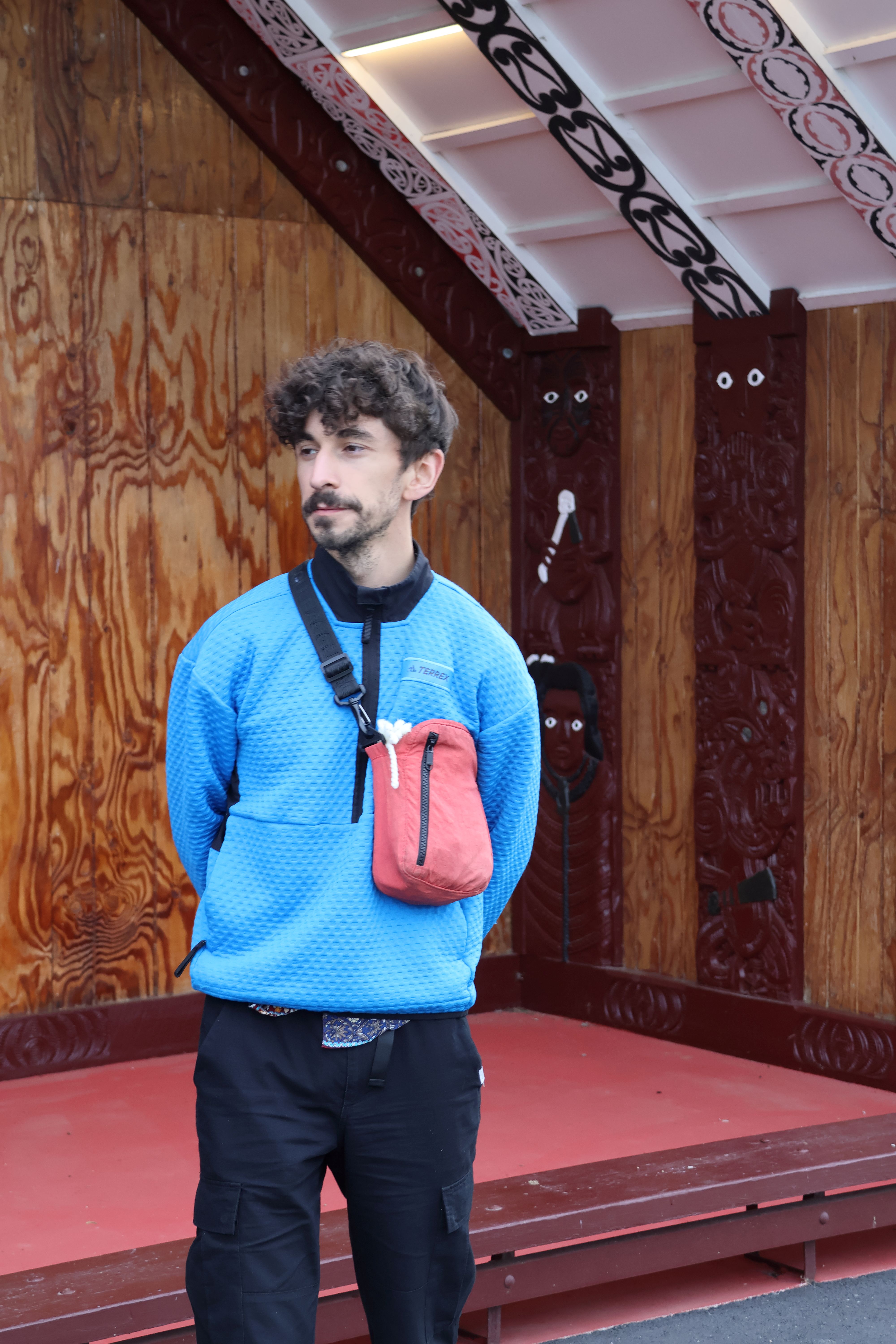In March 2024, 18 people from the Xwémalhkwu First Nation in British Columbia landed in Aotearoa New Zealand to embark on a trip like no other. Over the next 12 days, they would meet iwi and hapū /Māori tribal units from around the country, to share experiences and knowledge first-hand, all in aid of raising a future generation of leaders.
Learning and cultural exchanges between Indigenous Peoples around the world are key to global conservation. Meeting face to face is a powerful way to foster knowledge, ideas and values transfers and to create lasting relationships that create support networks for shared problem solving. The Nature Conservancy and our Canadian affiliate Nature United are proud to support these exchanges to foster diffusion of community-led conservation and practices.
Supporting the next generation of leaders is a shared Indigenous value, and this trip was specially designed to foster sharing of knowledge across generations and Indigenous cultures.
“Be an open door for your young people—they are full of ideas and will jump at the opportunity to share them,” said Tiare Iti, Waikato-Tainui speaking to the group at Rangiriri Paa.
Creating the next generation of stewardship leaders helps youth leaders find stewardship jobs and helps create local sustainable economies that are grounded in Indigenous values. This helps communities build sustainable natural resource management and sustainable livelihoods, while supporting their people, cultures and well-being.
Follow them as they travel around the country.

From Tāmaki Makaurau, the roopu headed North to Te Tai Tokerau, where they were met with a wero at the Treaty grounds. It was the first time the visiting Xwémalhkwu group had been met by a wero during Pōwhiri proceedings and it was something the young group members in particular, were inspired by.
Chief Darren expressed the intention behind the visit, but also the intention behind bringing their youth. “Mostly we came to learn what the Māori do in their territory, how they look after their lands and waters, and how they execute their authority over their territory,” He says. “We’re looking to do the same in our territory, and we’re looking to have our young people learn as they’ll be looking after the lands.”

Some of the younger ones in the group are guardians, and are learning to look after the land and learn the place names, so the connection between language and land is an intrinsic part of the shared values between Māori and the Xwémalhkwu people. He further highlights, “our language is connected to the land so the guardians have to develop that connection and the expertise in the territory so that they can look after it—as we look after the land the land looks after us,”
With forestry being such a major enterprise in their home, Chief Darren expressed the importance of bringing their forester, Joanna Dobson, as they’d like to learn how Māori are doing forestry in a way that is less intensive and economically just as viable. “As we become less intensive in our forestry, then our salmon will do better, because right now, with the way logging practices are, our salmon suffer from that and our populations decline.” The Xwémalhkwu aim to buy out forestry tenures so they have autonomy over forestry decisions that impact their territory and the sustainability of their salmon.

Following whakawhanaungatanga with Ngāti Hine and Ngāti Te Tarawa at the Treaty grounds, and a venture to see the waka down at the beach, the group was taken to the Manea Footprints of Kupe. It was a fully immersive event, with actors on stage telling the story of Kupe and a 4D experience.
For one of the group members, the story held greater gravity for her. Charity Perrault, who works with the youth, has lost two sons, and the story of Kupe leaving his son behind felt poignant. During the visit to see Tāne Mahuta, the largest known living Kauri tree the next day, Charity shared a deeply spiritual exchange with one of the hosts, who took her to a place where they could view the treetops, and release what she was holding. Charity shared, “it’s amazing how much easier it is to heal on another land, that isn’t your own, but you feel deeply connected to.”
The roopu experienced their first Marae stay at Te Whakamaharatanga marae, where Eamon Nathan who visited Campbell River on the first exchange in 2019, spoke about the projects he works on.
Chef Joe McLeod also visited and spoke about the kai sessions he was hosting the next day at another Marae nearby. He invited everyone to join, and though there was interest, the itinerary was pretty set. By some divine intervention however, the bus broke down that next day on the way back from Tāne Mahuta—right outside the marae he was hosting at.
The roopu were able to go in and participate whilst the bus got sorted, and the discussions were rich in kōrero around food sovereignty and reconnecting to traditional foods. Northland seemed to bring serendipitous moments, and organic exchange, which indigenous communities are so aware of as important signs and intentional interventions from the taiao! One of the silver linings within this uncanny breakdown, was being able to indulge in some beautifully prepared salmon—something the group of course have high standards on!
Visiting Te Tai Tokerau (Northland)

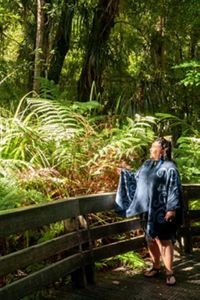



Visiting Te Tai Tokerau: Thomas Hohaia and his daughter Pare Hohaia exhibiting poi before gifting them to some of the wāhine in the visiting Xwémalhkwu roopu. © Nikolaj Lasbo/TNC

Visiting Te Tai Tokerau: Heni Matthews at Tāne Māhuta, the largest living Kauri tree in Aotearoa. © Nikolaj Lasbo/TNC

Visiting Te Tai Tokerau: Henry Blaney, Chief Darren’s son at the Marae with Eamon Nathan. © Sebastian Kalkoff

Visiting Te Tai Tokerau: The Xwémalhkwu group and TNC guests with their Ngāti Hine hosts outside Te Whare Rūnanga. © Sebastian Kalkoff
Fred Coupal, who grew up away from his people, with his non-native father, shared that the exchange is teaching him so much about the similarities between the two cultures. He says, “All I knew about the Māori was from a video I’d seen of a Māori warrior doing one of their dances—and I thought it was pretty intimidating to watch. Other than that, I didn’t know anything about the culture or the people, and I had no idea just how close our experiences were with colonization—almost identical.”
The engagements on Marae, through song, dance and food has inspired a desire to put more emphasis on recovering songs and language, and encouraging more people to become involved. Frank says, “I hope the next time I’m back here in your Marae, that I’m able to speak my language, and show you that your inspiration has made me and others go and learn.”
Quote: Kai
It’s mainly about reconnecting to ourselves and forming a connection with people around the world who have experienced similar events of being colonized and finding the solutions that other people have found to reconnect into who they are after that loss that has come from it.
Ned Peita, a Rangatira of Ngāti Te Tarawa, Ngāti Hine, shared the importance of exchanging stories and supporting one another. “They’re here, looking for a way forward, and getting some support from the Waitangi Trust today, Tai Tokerau and Ngā Puhi. Hopefully they go around the rest of the country and see the support that’s here for their dreams and aspirations,” he says. “I’m just glad we were here to hear their story and know and feel the same pain that they feel.”
Kai, Chief’s son and Guardian of the land and forest, shared the importance of seeing and hearing from other colonized groups and learning how to gain strength and a sense of self. “It’s mainly about reconnecting to ourselves and forming a connection with people around the world who have experienced similar events of being colonized and finding the solutions that other people have found to reconnect into who they are after that loss that has come from it.”
Visiting the Waitangi grounds and being in a place of such historical significance in Aotearoa was a powerful opportunity to gain insights into the history of Aotearoa and the shared traumas of both Indigenous groups—particularly this early in the trip, where it could form foundational context to the projects and movements happening around the motu.
Use your stories and your narratives to restore your people for future generations
Xwémalhkwu me ngā Iwi Māori—Cultural Exchange
Arpége Taratoa (Ngāi-te-Rangi, Ngāti Ranginui, Ngāti Raukawa, Ngāpuhi, Ngāti Rārua)
Waikato
Note: Waikato-Tainui use the double vowel system (aa) rather than macrons (ā) to indicate a lengthened vowel sound when pronounced.
Quote: Kiingi Taawhiao Pootatua Te Wherowhero
Ki te kaahore he whakakitenga ka ngaro te iwi—without foresight or vision the people will be lost.
This was a quote by Kiingi Taawhiao Pootatau Te Wherowhero, shared with the Wxémalkwu when they visited Waikato Tainui, in the third location of their exchange.
Following a deeply moving experience at Rangiriri Paa, the roopu (group) visited Hopuhopu, an old army base that the iwi now own and use as their tribal headquarters for iwi projects and leadership hui, where rangatahi (youth) from Waikato-Tainui’s Te Pito Whakatupu programme presented on their initiatives. When asked for insights and words of wisdom, Tiare Iti, one of the young women who presented to the roopu, said simply, “be an open door for your young people—they are full of ideas and will jump at the opportunity to share them.”
They shared insights into the frameworks they have explored, and the processes they have engaged in with uri (descendants), to generate action plans from the barriers that exist and the dreams and aspirations of their young people. Something that leaders of Wxémalkwu acknowledged was the lack of action that came from a healing retreat they hosted for their people, and drew some tangible processes from the rangatahi of Waikato.

Whilst conservation and returning of lands is a strong theme across the exchange, and how to be self-sustaining long-term, there have been some astounding cultural and spiritual experiences that really speak to the transcendental connection between Indigenous across the globe.
The second day in the Waikato saw the visitors paddling up the awa (river) toward Tuurangawaewae Marae, learning about significant sites along the eponymous river; the night prior, on the full moon lunar eclipse, the Wxémalkwu received word of a loss back home. This individual was a mentor for many in paddling, and in the physical challenge of paddling upstream that day—a lot of healing was experienced by the First Nations manuhiri (guests).
Receiving the responsibility from their ancestors to protect the natural world
Arpége Taratoa (Ngāi-te-Rangi, Ngāti Ranginui, Ngāti Raukawa, Ngāpuhi, Ngāti Rārua)
Waiharakeke
Te Tau ihu o te waka-ā-Māui, the top of the South Island, is naturally where the Wxémalkwu began their journeys in the south, hosted first by the people of Ngāti Kuia in Waiharakeke Blenheim.
The day had been full of travel from the north, so the first afternoon was spent in pōwhiri and whakawhanaungatanga (process of establishing relationships, getting to know each other)—and of course beautiful kai (food)!

Welcomed first at Omaka Marae and then Te Hora Pā (the heartland of the tribe), the evening was spent on the introduction of tribal narratives, and the introductions of people. This whakawhanauntanga gave everyone the opportunity to share who they were, and broke barriers quickly - many tears were shed and plenty of laughter amongst it all!
The time spent with Ngāti Kuia largely concentrated on their environmental work, and whakapapa pūrākau (ancestry narratives/stories). Raymond Smith, the Cultural and Taiao Advisor, explained the intersection between genealogy and te taiao (the natural environment) for Māori in relation to Māori origin stories.
Many from Aotearoa (New Zealand) will be familiar with the stories of Ranginui and Papatūānuku, the sky father and earth mother separated by their children to bring light and life into the world. Through their art forms, narratives and waiata (songs), Māori can trace their lineage all the way back to these tūpuna (ancestors), and with that knowledge, hold deep aroha (love) and responsibility to protect the natural world. A beautiful painting hung in one of the first buildings given back to the tribe in settlement proceedings, depicting this creation story.

Ko Ngāti Kuia he iwi Pakohe mai tū te iwi karakia! Ngāti Kuia is the iwi of Pākohe—a unique Argillite to the Nelson/Blenheim regions of Aotearoa. From their arrival, it was clear that descendents of Ngāti Kuia took great pride in this stone—not just because of its visible beauty when carved into tāonga (treasures, objects) or adornments, but because of the narratives surrounding it that connect them to this beautiful whenua (land).
Ruihana Smith, the Te Pou Hāpai Tāiao of the iwi (tribe) said, “we have a thing that we call taunahanaha, or taunahanaha whenua, and essentially, our whakapapa, our genealogy is embedded into the landscape, in the features of the landscape.”
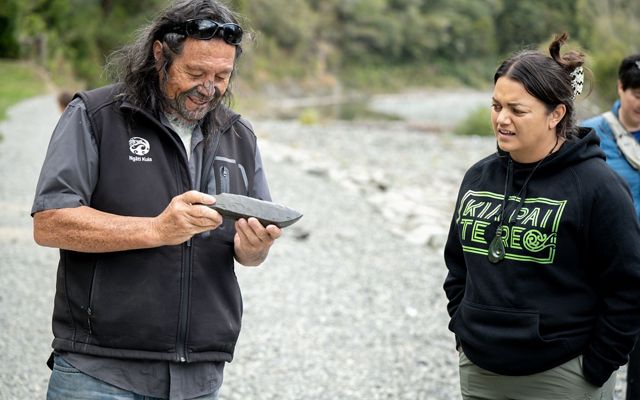
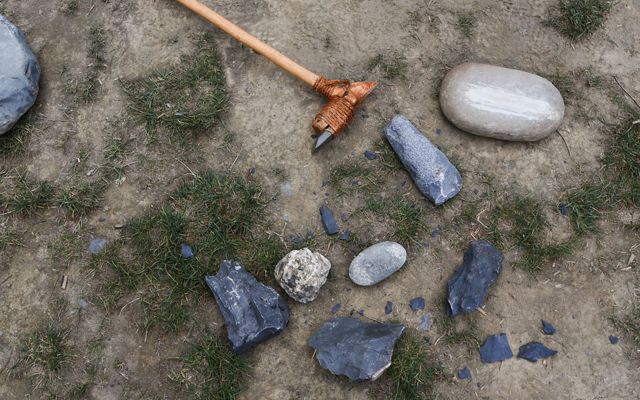
One of the key projects shared was the Te Hoiere Project, a partnership between tangata whenua (indigenous people), district council and local community with the Department of Conservation and Ministry for the Environment.

Waihaere Mason, Ngāti Kuia representative and Trust Co-chair on the Te Hoiere Project, highlighted that whilst the iwi feed into the economic wealth of the valley in small ways (hay and silage for stock, mussel farm interest, forestry, marae), they are accepted as equal partners in putting things right in the taiao (natural environment), and work on the project both at a governance and management level. He said, “you can in fact make good, out of poor; by ensuring the practical application of the values we hold dear - mātauranga Māori (Māori knowledge).”
It was poignant for the Wxémalkwu to see that no matter what a tribe's financial situation—they can still make a significant contribution and change to the ecological, social and cultural standing of their communities.
Kai, Chief Darren’s son, said that the kōrero (discussion) around the impact of forestry sediment on the ocean and kaimoana (seafood) was of particular note for him as the guardian of land and ocean for their tribe.
Quote: Ruihana Smith
We have a thing that we call taunahanaha, or taunahanaha whenua, and essentially, our whakapapa, our genealogy is embedded into the landscape, in the features of the landscape.
“Even though we had a short amount of time…that was really interesting to me because it’s very closely related to us. All of our main rivers in our core territory have been forested, and there’s a lot of muddy beach.”
Kai further explained the stories they have heard from elders about the games they would play on those beaches, but if you were to go there now, you’d be a foot deep in mud. Chief Darren said they are looking to purchase a forestry company so they can extend their riparian zone and work on reducing sediment in the waterways.
The Wxêmalkwu were taken to the Pekapeka project at Kahikatea Flat, focussed on regeneration and pest control. Shannon Huntley of Ngāti Kuia, the kaitiaki (caretaker) for the Pelorus campground spoke about their work with DOC and more importantly, their work in biodiversity. Within the area, there are several roosts of long-tailed bats, which is one of the only two remaining species in Aotearoa, with an estimate of only two hundred remaining bats. The team rely heavily on volunteers to support the control of pests and regeneration of natives—and the concern is really around space and homes for these bats to re-populate.

The final visit was at Titiraukawa, where the iwi have realized their dream to build a Kānuka (white tea-tree) processing plant. The group was shown through the facilities, and able to participate in the rubbing of dried kānuka to produce a tea and water - one for external use and one for internal consumption. The kānuka has an array of medicinal purposes and the iwi will be producing these once the new development is completed in winter.

Joanna Dobson, a Forester for Wxémalkwu, mentioned how interesting it has been seeing how involved iwi are in the regeneration of Natives and the amount of iwi led initiatives around biodiversity, given it is part of the law in Canada.
Standing at Titiraukawa, Joanna looked at the hills and saw a fascinating depiction of Aotearoa. In the foreground stood a farming hill, a pine tree hill behind it, and in the rear - a hill covered in natives.
At the base, the location where Ngāti Kuia’s oldest ancestor Matua Hotere tied up his waka after traveling through the Marlborough Sounds over a thousand years ago - the development of the iwi Kānuka project and native bush nursery; a beautiful symbol of what was—being revitalized by this generation.

Quote: Rōpata Taylor
The river is fundamental to sustaining our community. The water and our relationship with our water is at the heart of the relationship we have with our land; and it keeps everything fertile—so we revere the river.

Te Āwhina Marae, of Ngāti Rārua and Te Ātiawa iwi (tribes), is, as the name suggests, a welcoming place for all—this is where the Wxémalkwu group spent their time in Motueka. (awhi = support or care)
Over the years, much was done by the Crown that did not acknowledge, consult with or compensate the rightful Māori owners of the Nelson Tenths. Wakatū Incorporation, the entity established by the descendants of the original owners of the Tenths, has funded and led this litigation since 2009, on behalf of all of Ngā Uri.
Ngā Uri is currently awaiting a decision on the remedies proceedings from the High Court case, which was heard in 2023, as the Crown continues to contest and challenge the outcomes of the Supreme Court’s decision in 2017*. Interestingly, they looked to the Canadian Jurisdiction because of their similarity of legal structure, and it was helpful in their case to consider what responsibility a government has to its own citizens to treat them with honour, and what the honour of the Crown is toward Indigenous people.
Kaiteretere was the place in which the tūpuna (ancestors), whānau and hapū (family and sub-tribes) of Nelson, Tasman and Mohua agreed upon the settlement of Nelson by the New Zealand Company. The Wxémalkwu were taken there to paddle out and welcome in the sun through a traditional morning ceremony. On arrival, the sky was showing hints of pink and red, and as the saying goes, “red sky in the morning, shepherd’s warning…,” yet following a deeply moving ceremony, where two Indigenous groups sung to the sun and welcomed him into the morning, Tamanui-te-rā (the sun) rose softly, dispelling clouds—and the day was bright and warm.
Everywhere we saw balance, a pivotal concept in te ao Māori (the Māori worldview) and in the universe alike. As the sun rose, the moon shone on the opposite sky, relinquishing the night to the day. As every individual sang special words in each language, tears of pain and joy flowed and released into the water. For many on board the waka (canoes), they shared their pain and grief for their languages and the sounds of their songs—the loss of their ancestors into the present day. And as the collective released their sorrows, they embraced the healing that came—it was a magical, powerfully potent experience I’m sure nobody will forget.


The rest of the day was spent exploring some of the land that is a part of the Nelson Tenths rohe (area) throughout the Abel Tasman National Park, known as Aorere, via boat. One of the beaches that wasn’t a drop-off point contains all privately owned holiday homes on the waterfront, which Barney Thomas, kaumatua (elder) and trustee of the Whakarewa area and board member of Wakatū, shared was one of the areas being discussed in the court case.
Where the Crown has already sold the land, there has to be investigation into the loss for the original owners and what this means in terms of how it can be addressed via the legal proceedings.

Views of the pou whenua (land posts) at Wairima/Bark Bay as the roopu (group) leave the beach.
Upon returning to the marae, it was evident that the experiences of the day had been deeply moving—a shifted energy amongst all. That evening, a poroporoāki (farewell) was held and there was a beautiful exchange of gifts and waiata (songs). Travelling with the Wxémalkwu for the whole trip, it was evident how much growth had happened in such a short timeframe because of this cultural exchange. Dominic Fode shared that “doing them every day really helps—even just doing them once a week you forget a lot, but this is a different kind of practice.”
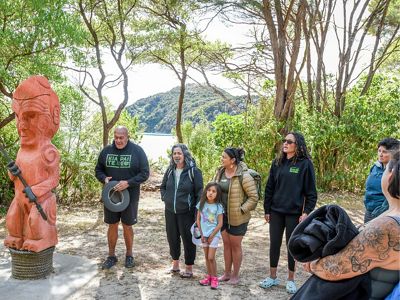
For Dude, Chief Darren’s grandson, the exchange has really made a difference in his singing. He has aspirations to study music once he completes his final year of school and observing the Māori songs and haka (war dance) have been transformational. “How we were singing the first time was really quiet. I’ve taken inspiration from the Māori men—I noticed they don’t sing from their throat, but they breathe and project from their diaphragm. So, I started doing that and being louder and stronger.”

Left to right, from Ngāti Rārua, Te Ātiawa: Aneika Young, Ngawaina Shorrock, Rachelle Loos (Wxémalkwu), Arpége Taratoa (Ngāti Rārua), Fred Coupal (Wxémalkwu), Kristie Pakipaki (Te Ātiawa), and from Wxémalkwu: Laura Smith, Joanna Dobson and Chief Darren Blaney.
*Since the visit to Te Tauihu, the High Court has released part of their decision which was strongly in favour of Ngā Uri. The Crown has decided to appeal the High Court decision. You can read more about the case here.
With your food basket and my food basket, the people will thrive
Xwémalhkwu me ngā Iwi Māori—Cultural Exchange
Arpége Taratoa (Ngāi-te-Rangi, Ngāti Ranginui, Ngāti Raukawa, Ngāpuhi, Ngāti Rārua)
Murihiku
Te mutunga o te haerenga—the final leg of the trip brought the group to the deep south, the bottom of the island, known as Te Waipounamu or Te Waka a Aoraki. Landing in Waihōpai Invercargill on Good Friday, a heavy cloud and cool winds introduced the roopu (group) to Murihiku / Southland—having just come from winter at home in Canada, the cold was a comforting familiarity for some. It had been a long day, a long week of travel, and it was great to check-in, devour some hearty winter kai at the hotel restaurant and get some rest in their own spaces.
The Marae stay experiences reminded the Wxémalkwu of their Potlach back home—similar in the sense of wānanga (meetings, tribal knowledge-sharing gatherings) and long days and nights together. Getting a chance to be in one's own space, however, and recuperate was a great way to prepare for the next day.
The morning started with a Pōwhiri (welcoming process) at the stunning Murihiku Marae, a unique building and whare which undertook redevelopments a few years ago and reopened in mid-2023. The vision for the Marae was to expand on community support services and provide a hub for educational initiatives, and the iwi are also looking to build more kaumatua (elderly) flats, doctors’ facilities and youth justice homes.

Aside from the beautiful facilities, the mahi toi (artwork) was a highlight and topic of conversation, where stories were shared of youth and community involvement in the embellishment of the building. Some of the carving, tukutuku (woven) panels and kōwhaiwhai (painted ornamentation) inside the wharenui (meeting house) were contributed to by local rangatahi (youth) who were struggling in school or not attending—they were brought to the Marae and learned these skills alongside masters.
This mirrored some of the stories shared at Te Āwhina Marae, where some of the local tāne (men) were involved in learning the carving styles of different rohe (regions) to create the pou (carved ancestral posts) for the whare (house). The group were fascinated by the differences in carvings and paintings across different Marae.
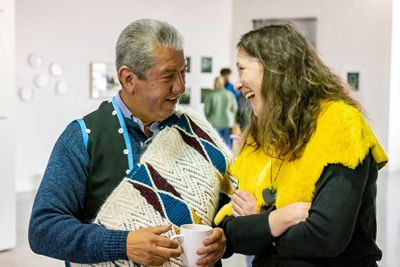
The following day saw the roopu visit Te Atāmira Gallery in Tāhuna Queenstown and also experience the Shotover Jet owned and operated by the iwi. One of the elders of the group, Garrold, was grinning ear to ear after the exhilarating jet experience, which for him, was an absolute highlight.
The unique design of the jet, which allows it to glide along such shallow depths—Kai suggested they investigate it for their own tourism ventures back home, though the waters of Campbell River are a lot more turbulent!


Nearing the end of the trip, the roopu were able to sight see in Tāhuna and try out some of the attractions or head to Bluff with Dean to Awarua Marae—a uniquely designed wharenui (large/main meeting house) and wharekai (dining hall) by renowned artist Cliff Whiting. Gabriell Huria, another member of the Ngāi Tahu group who visited Campbell River in 2019, had stayed behind at Murihiku over the weekend with her wider whānau (family) to prepare all the kai (food) whilst the guests were out and about, for the poroporoāki (farewell).
As one of the few women who knows the dances of her people, Naia is very conscious of the time in which they have left with the older women. “I think I’ve noticed how involved all the youth are with their culture and how they know their language. I need to learn our language because only my papa’s generation know it, and they’re all passing away.”
In reflecting on the exchange in its entirety, where TNC first took a roopu over to Canada in 2019, and now being able to return the hospitality here in Aotearoa, Dean shares, “it was a wonderful trip. Gabrielle, Aaron and I learnt a lot, and by exchanging and Wxémalkwu coming here the last couple of days and across New Zealand as a whole, the hope is that they continue to share their knowledge and where their journey is, and the same with us where we can share with them our knowledge and our journey—to support each other.”
Quote
Nāu te rourou, nāku te rourou, ka ora ai te iwi—with your food basket and my food basket, the people will thrive.
We Can’t Save Nature Without You
Sign up to receive regular updates from The Nature Conservancy.











